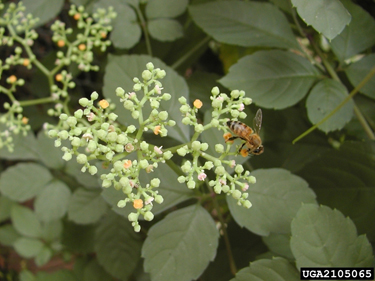Sign up for the iWire to get breaking news, event info and the species spotlight.
Go Back | Printer Friendly Fact Sheet
NOTE:
Cayratia japonica
Bushkiller
Synonym(s): Causonis japonica, Cissus japonica, Cissus tenuifolia
Columella japonica, Vitis japonica, Vitis leucocarpa
and Vitis tenuifolia
Family: Vitaceae
Duration and Habit: Perennial Vine

Photographer: Robert J. Richardson
Source: North Carolina State University
Description
A perennial vine in the grape family with palmately compound leaves that are 1-3 inches long and 0.5-3 inches wide. Leaflets are ovate and pointed. Flowers are very small, occurring in terminal clusters on panicles; they are orange-pink and cup-shaped. Fruit is a round berry with 2-4 seeds.
Native Lookalikes: Currently no information available here yet, or there are no native Texas species that could be confused with Bushkiller.
Ecological Threat: This vine kills native plants and shrubs by blocking light and stressing plants with its weight. Very difficult to remove once established. Climbs trees and may act as a ladder for forest fire in which flames reach higher and do more damage.
Biology & Spread: Rapidly reproduces via sprouting from roots. Able to reproduce by seed; however, flowers usually fall off, and fruit does not set in the Gulf Coast region. After sprouting, bushkiller is a rapid grower, quickly forming smothering mats of vegetation over the canopy of its host.
History: It is occasionally cultivated as an ornamental in North America.
U.S. Habitat: Prefers disturbed areas including harvested forests, fallow fields, overgrazed pastures, and residential areas. Also thrives in moist river bottoms, and forest margins.
Distribution
U.S. Nativity: Introduced
Native Origin: Southeast Asia
U.S. Present: AL, LA, MS, SC, TX
Distribution in Texas: Reported as a problem weed at Mercer Arboretum in northeast Houston.
Mapping
Invaders of Texas Map: Cayratia japonica
EDDMapS: Cayratia japonica
USDA Plants Texas County Map: Cayratia japonica
Invaders of Texas Observations
List All Observations of Cayratia japonica reported by Citizen Scientists
Native Alternatives
Management
Mechanical: When hand pulling this vine, remove all roots of seedlings to avoid re-sprouting from the roots. Do not compost vines as this will propagate the plant.
Chemical: A cut-stem application of a Glyphosate herbicide such as Roundup or Campaign can be used to control large vines. Treatment is best at 70°F or above, while plants are actively metabolizing. Unwrap vine from supporting vegetation and spread out away from non-target vegetation prior to spraying. Mercer Arboretum in Humble, Texas has had some success in controlling this vine using a non-selective, fermented-vinegar and citric acid-based natural herbicide known by the name of BlackJack 21 Weed Stomper.
Text References
The Global Invasive Species Team. 2006. Weed Alert!: Cayratia japonica. Accessed February 2010: http://www.invasive.org/gist/alert/alrtcayr.html
The Galveston Bay Estuary Program. 2007.THE QUIET INVASION: A Guide to Invasive Plants of the Galveston Bay Area Online Version. Accessed January 2010: http://www.galvbayinvasives.org/Guide/Species/CayratiaJaponica
Online Resources
Search Online
Google Search: Cayratia japonica
Google Images: Cayratia japonica
NatureServe Explorer: Cayratia japonica
USDA Plants: Cayratia japonica
Invasive Plant Atlas of the United States: Cayratia japonica
Bugwood Network Images: Cayratia japonica











